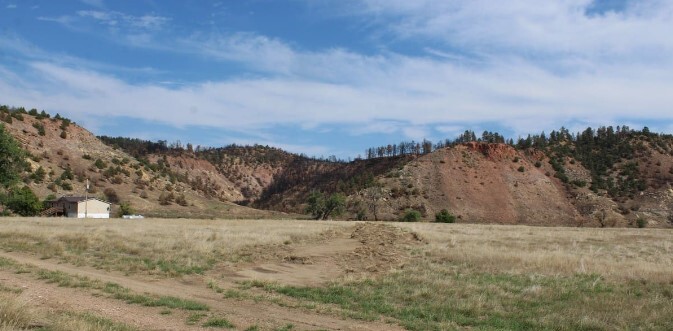DECKER — Judy Musgrave traced two distinct burn scars, patches of earth charred black by a recent wildfire, snaking toward her riverside home. She stood on her balcony, just a few miles north of Tongue River Reservoir, pointing toward scorched tree trunks and burned-over grass on the opposite bank. They were visceral reminders of the Deadman Fire complex, four distinct blazes that together burned almost 50,000 acres in July. Musgrave had first spotted the approaching fire as it crested a ridgeline to the south on July 13.
“I told my kids, as soon as I saw flames I’d leave,” Musgrave said.
She took only a few belongings and her black-and-gray tabby cat on what became an eight-day absence from home. While she was away, the fire consumed the slope across the river from her house.
Less than a month later, the Barber Draw Fire approached her house via a gully, this time from the north, reports the Montana Free Press.
This time, Musgrave said, “I didn’t have the river for projection.” She evacuated again, for two days. She returned to find burned grass just a few hundred yards from her lawn. Later, Big Horn County dispatched a team to dig a “fire guard,” a buffer of overturned dirt, around her property. The shallow trench line and river now encircle Musgrave’s house, transforming the land into a makeshift fortress against fire.
Musgrave lives just north of Tongue River Reservoir State Park, which was put under evacuation warnings for both the Deadman Fire complex and the Barber Draw Fire.

The Badger Fire, a late-July blaze that began near Sheridan, Wyoming, before crossing into Montana, sparked another evacuation warning for the park. As that fire approached Tongue River Reservoir from the south, Big Horn County Sheriff Jeramie Middlestead issued an evacuation warning. At 4 a.m., with help from park manager Raymond Schell, Middlestead informed each overnight park visitor of the imminent fire danger. The evacuation concluded by 9 a.m. The blaze eventually slowed to a halt several miles south of the park’s main recreation areas.
The Barber Draw Fire came much closer to the reservoir, burning up to the northern shore of the lake. In late August, fire responders encouraged Fish, Wildlife and Parks to close the lake so firefighting aircraft could collect water. While Schell lacked the authority to formally close the lake to the public, he did shut down the boat ramps, preventing new watercraft from launching and effectively clearing the lake of boats. On Aug. 23, FWP and Department of Natural Resources and Conservation leadership approved the request to officially close the lake. With waterborne recreation off limits, and in the wake of its third evacuation warning of the season, the park experienced limited traffic during late August and the early days of September.
The Bogers family, which owns and operates a small general store in the middle of the park, never left. According to Laurie Bogers, who co-owns the store with her husband, Ryan, the period between Memorial Day and Labor Day is usually their busiest season. By the fourth of July, the store was on track for a more profitable year than last. The tide turned less than a month later.
“We got one evacuation — not a big deal,” Bogers said. A week later, the Badger Creek Fire triggered another evacuation warning. August brought the Barber Draw Fire, causing a third.
“It just kept getting worse and worse,” Bogers said.
Bogers estimates the store has suffered a 50% loss in revenue compared to this time last year. Most seasons, the store cuts back its hours as visitors dwindle during the early autumn. But the Bogers now plan to work more hours to keep the store open later in the season.
“It’s not going to be fruitful,” Bogers said. “And we understand that, but we’re going to be open to try to bring in a couple hundred bucks here and there. ”
While Tongue River Reservoir was under an evacuation restriction for the third time, the Barber Draw Fire brought in some business of its own. Firefighters set up camp at the park and, according to Bogers, enjoyed access to the store’s energy drinks, gummy candy and ice cream.
On Aug. 24, a plume of smoke rising from the Remington Fire reflected off the surface of Tongue River Reservoir, portending a brief extension of the firefighters’ stay. The Remington Fire’s main fire camp is now centralized in Buffalo, Wyoming. For Ed Grywusiewicz, a maintenance worker at Tongue River, the park’s short stint supporting firefighters is a source of pride.
“This place was an absolute blessing during the fires,” Grywusiewicz said. “We lost a lot of business, but it was worth it.”
The firefighters may be gone, but the charred evidence of wildfire remains scattered across the rugged terrain. On both sides of Tongue River Road, a dirt track cutting north through the park, burn scars dominate the landscape.
“I have been here for 42 years,” Musgrave said. “And I’ve not had any fire in this little valley.”
“The grass will come back. That will all be green,” Musgrave said from her balcony, gesturing to the blackened slope on the far side of the river. “But I won’t see trees again in my lifetime.”
RELATED Q2 Coverage
Deadman Fire severely impacting seasonal business on Tongue River
Tongue River Reservoir State Park evacuated third time due to fire
Evacuation notice issued near Tongue River reservoir for 5,000-acre fire
Wildfire forces mandatory evacuation at Tongue River Reservoir
Evacuation status at Tongue River Reservoir reduced to 'warning'


